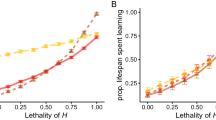Abstract
In this paper I propose a reinforcement learning model for a predator preying upon two types of prey, the unpalatable (noxious) models, and the palatable mimics. The latter type of prey resembles the models in appearance so as to derive some protection from the predator who must avoid the unpalatable models. Essentially the predator is treated as a learning automaton adopting a simple reinforcement learning strategy in order to increase its consumption of palatable prey and reduce the consumption of unpalatable ones. The populations of both mimics and models are assumed to grow logistically.



Similar content being viewed by others
References
Arnold SJ (1978) The evolution of a special class of modifiable behaviors in relation to environmental pattern. Am Natural 112(984):415–427
Bobisud LE, Potratz CJ (1976) One-trial versus multi-trial learning for a predator encountering a model–mimic system. Am Natural 110(971):121–128
Bush RR, Mosteller F (1955) Stochastic models for learning. J. Wiley & Sons
Estabrook GF, Jespersen DC (1974) Strategy for a predator encountering a model–mimic system. Am Natural 108(962):443–457
Gamberale-Stille G, Guilford T (2004) Automimicry destabilizes aposematism: a predator sample-and-reject behaviour may provide a solution. Proc Roy Soc Lond B 271:2621–2625
Guilford T (1994) “Go-slow” signalling and the problem of automimicry. J Theor Biol 170:311–316
Huheey JE (1964) Studies of warning coloration and mimicry. IV. A mathematical model of model–mimic frequencies. Ecology 45(1):185–188
Kannan D (1983) A Markov chain analysis of predator strategy in a model–mimic system. Bull Math Biol 45(3):347–400
Luedeman JK, McMorris FR, Warner DD (1981) Predator encountering a model–mimic system with alternative prey. Am Natural 117:1041–1048
Narendra K, Thathachar MAL (1989) Learning automata: an introduction. Prentice Hall
Owen RE, Owen ARG (1984) Mathematical paradigms for mimicry: recurrent sampling. J Theor Biol 109:217–247
Ruxton GD, Speed MP (2006) How can automimicry persist when predators can preferentially consume undefended mimics. Proc Roy Soc Lond B 273:373–378
Ruxton GD, Sherratt TN, Speed MP (2004a) Avoiding attack: the evolutionary ecology of crypsis, warning signals and mimicry. Oxford University Press
Ruxton GD, Speed MP, Sherratt TN (2004b) Evasive mimicry: when (if ever) could mimicry based on difficulty of capture evolve. Proc Roy Soc Lond B 271:2135–2142
Servedio MR (2000) The effects of predator learning, forgetting, and recognition errors on the evolution of warning coloration. Evolution 54(3):751–763
Sherratt TN (2002) The cooevolution of warning signals. Proc Roy Soc Lond B 269:741–746
Speed MP (1999) Robot predators in virtual ecologies: the importance of memory in mimicry studies. Anim Behav 57:203–213
Speed MP (2000) Warning signals, receiver psychology and predator memory. Anim Behav 60:269–278
Speed MP, Turner JRG (1999) Learning and memory in mimicry: II. Do we understand the mimicry spectrum? Biol J Linn Soc 67:281–312
Tsoularis A (2006) Learning strategies for a predator operating in model–mimic–alternative prey environment. WSEAS Trans Biol Med 3(3):244–248
Tsoularis A, Wallace J (2005) Reinforcement learning for a stochastic automaton modelling predation in stationary model–mimic environments. Math Biosci 195(1):76–91
Turner JRG, Speed MP (1996) Learning and memory in mimicry. I. Simulations of laboratory experiments. Phil Trans R Soc Lond B 351:1157–1170
Turner JRG, Kearney EP, Exton LS (1984) Mimicry and the Monte Carlo predator: the palatability spectrum and the origins of mimicry. Biol J Linn Soc 23:247–268
Yamauchi A (1993) A population dynamic model of Batesian mimicry. Res Popul Ecol 35:295–315
Acknowledgements
The author wishes to express his sincere gratitude to all three referees for their extremely careful and thorough readings of this paper. Two of the referees kindly revealed their identities. I wish to thank Professor Estabrook for his appreciation and approval of this work which was partly motivated on work he did while back. I also wish to thank Professor Turner, another major contributor in the field, for his insightful comments and criticisms throughout the revision process. Their valuable suggestions and encouragement has been deeply appreciated.
Author information
Authors and Affiliations
Corresponding author
Rights and permissions
About this article
Cite this article
Tsoularis, A. A Learning Strategy for Predator Preying on Edible and Inedible Prey. Acta Biotheor 55, 283–295 (2007). https://doi.org/10.1007/s10441-007-9020-y
Received:
Accepted:
Published:
Issue Date:
DOI: https://doi.org/10.1007/s10441-007-9020-y




